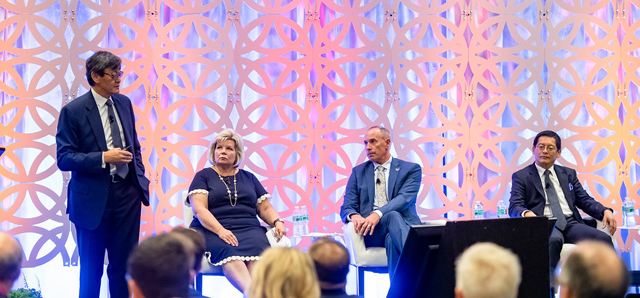Mission Critical: Enabling 21st Century Passenger Processing
![]() Print this Article | Send to Colleague
Print this Article | Send to Colleague

The subject of this session held on Monday “is something that is consuming a lot of time in the industry,” said moderator Candace S. McGraw, Chief Executive Officer, Cincinnati/Northern Kentucky International Airport: the passenger processing experience. But will a “happy passenger” and “airport” ever be entirely possible? Maybe not, because you cannot please everyone. But, after seeing and hearing about some of the amenities and processes incorporated at these three airports, true passenger happiness might, indeed, be a reality.
The speakers for this session were Brian Ryks, Executive Director/Chief Executive Officer, Minneapolis-St. Paul Metropolitan Airports Commission; Tan Lye Teck, Executive Vice President, Airport Management, Changi Airport Singapore; and Howard Eng, President and Chief Executive Officer, Greater Toronto Airports Authority. Each provided an overview of the types of initiatives they’ve taken to improve the passenger experience and some of the reasons behind their actions.
At Minneapolis-St. Paul, first they put together a top-notch staff then focused on their leadership strategy, all before progressing to the next steps: goals and focus areas. Ryks said they established their goals as: Safety, Security, Preparedness, Economic, Air Service, Talent, Innovation, Customer Service and Engagement. Their three focus areas became: (1) Develop new strategies to enhance financial strength; (2) Grow stakeholder and community engagement; and (3) Deliver a seamless ‘one journey’ experience for MSP passengers. Then they got to work. They implemented a parking reservation program, are building a new 5,000-space parking structure and are testing out a parking guidance system. They also worked on security passenger flow monitoring via Xovis, concessions updates such as adding grab and AtYourGate, point-of-sale data integration, biometric exit technology with Delta, and passenger flow and business intelligence.
When Teck described The Changi Experience, not only were the numbers jaw-dropping, so were the photos and video. In 2018, they had 65.6 million passengers, 386,000 total aircraft movement, 221,155 passengers on Dec. 21 and an average of 7,400 flights every week. “Every day we bring something interesting,” said Teck about their secret. “We try to go to the basics of understanding our customers.” He said this means making sure passengers don’t miss their flights, helping them from being separated from their luggage and making the flow of the airport intuitive. “We think passengers should have a clear, simple, intuitive way of finding things.” They also strive to make sure passengers feel happy on their journey through the airport. “We tried to make technology less intimidating and made it a shape and form that is easy to like.” At Jewel Changi Airport they even have a waterfall and indoor garden, a canopy park, slides and hedge mazes!
At Toronto Pearson, Eng said they have found that technology makes the process go quick and faster, “but at the end of the day, people are people.” At Toronto Pearson, they had 49.5 million passengers in 2018, so they have had a lot of opportunities to see what makes the passengers happy. “Our focus is FLOW,” he said. “We have to make the flow seamless for them.” They are also starting a known traveler digital identity program next year and have incorporated ACD-M, which allows everyone to share the same database. Signage is important to them too. “We are all working on signage,” Eng said. In this industry, we need high-tech and low-tech. “You don’t want the passengers getting lost.”
